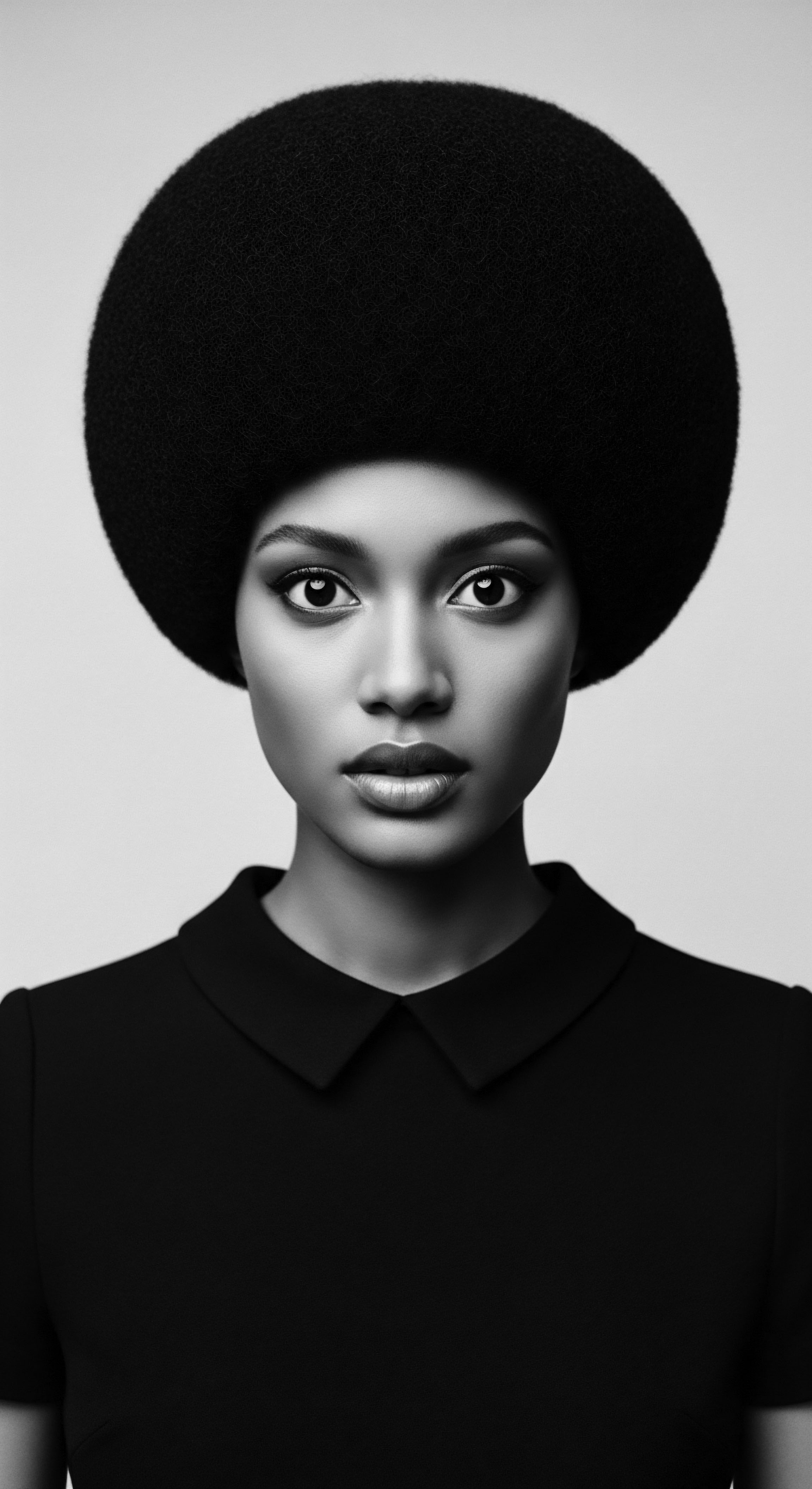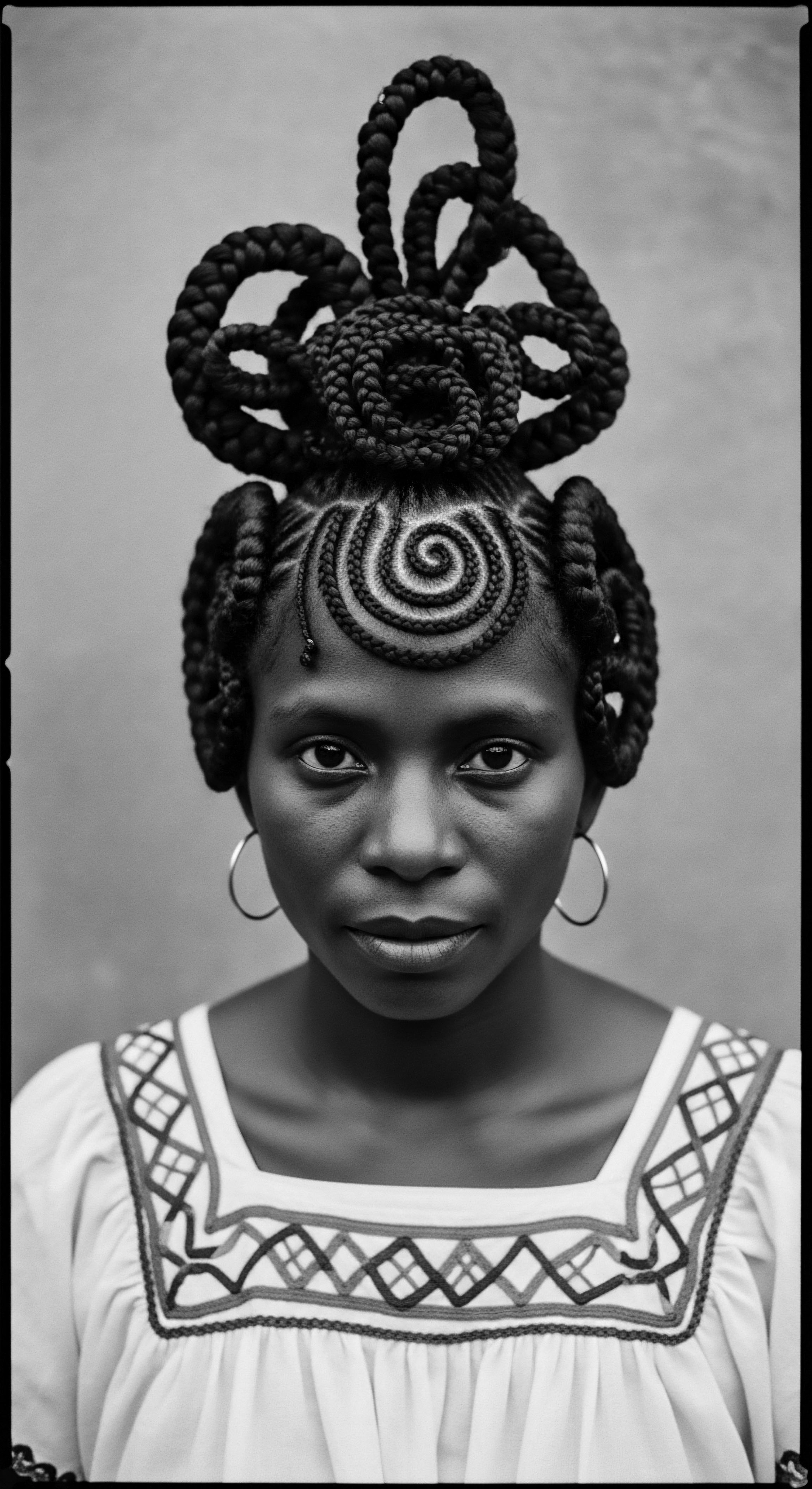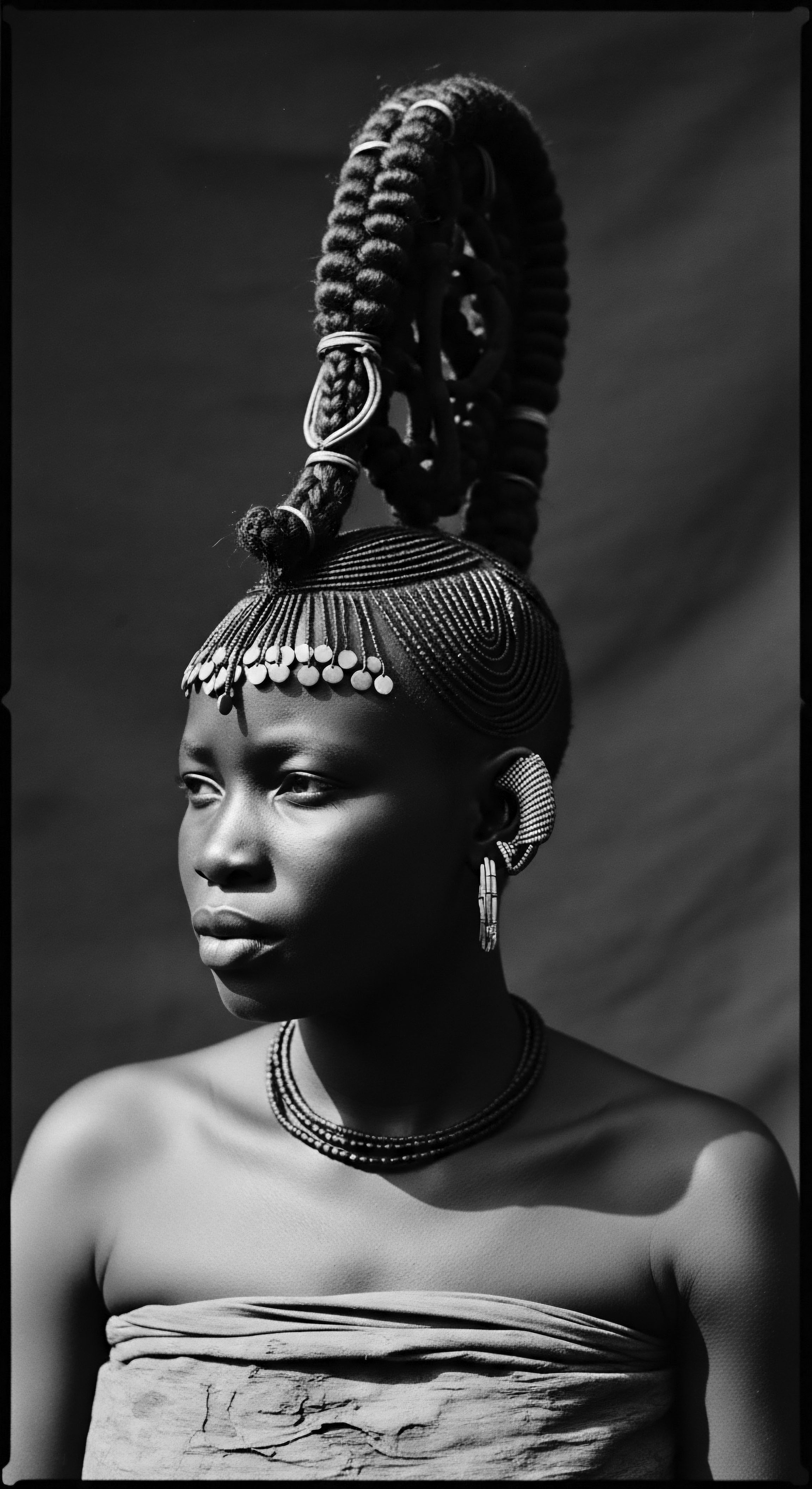
Fundamentals
The Ancient Comb, in its simplest manifestation, represents far more than a mere implement for arranging hair. It is a venerable artifact, a silent storyteller from the dawn of human adornment and self-care. For Roothea’s living library, this tool serves as a foundational text, a primary source illuminating the deep-seated connections between textured hair, ancestral practices, and collective identity. Its initial understanding is immediately grounded in the earliest historical and cultural contexts, particularly within the rich traditions of African and Indigenous communities, where the care of hair was, and remains, a sacred act.
This fundamental definition of the Ancient Comb begins with its primal purpose ❉ to bring order to the natural abundance of hair, to detangle the coils and curls that defy simpler instruments, and to prepare strands for styling. Yet, even in its earliest forms, its significance transcended mere utility. These combs were crafted with intention, each curve and tooth reflecting a profound reverence for the hair it touched. The act of combing became a ritual, a moment of connection between the individual and their heritage, a practice passed down through generations.
The Ancient Comb, a primal tool for textured hair, served not merely for grooming but as a sacred conduit for ancestral wisdom and identity in early human societies.

Echoes from the Source ❉ Materials and Their Ancestral Resonance
The very materials chosen for crafting Ancient Combs speak volumes about the ingenuity and spiritual awareness of early societies. Before the advent of synthetic compounds, artisans turned to the earth and its creatures for resources, transforming them into objects of beauty and function. Wood, often sourced from trees with specific medicinal or symbolic properties, provided a warm, gentle touch for delicate hair strands.
The grain of the wood, its innate strength, and its connection to the living forest imbued each comb with a natural spirit. For example, archaeologists have discovered combs made from wood dating back 6,000 to 7,000 years in ancient civilizations like Kush and Kemet (modern-day Sudan and Egypt), often decorated with symbols of nature such as birds, bull horns, and hippopotamuses, signifying a profound respect for the natural world and its creatures.
Bone and Ivory, remnants of animals held in high regard, were prized for their durability and smooth finish. These materials, too, carried a spiritual weight, linking the comb’s user to the strength and spirit of the animal from which it came. In ancient Egypt, combs crafted from ivory were often adorned with elaborate animal motifs, suggesting a connection to ritualistic hunting or ceremonial festivals. The meticulous carving of these materials into long, wide teeth was a direct response to the needs of textured hair, allowing for gentle separation without causing undue stress or breakage.
Even Metal, when it became available, was carefully selected and worked, sometimes incorporated for its strength or its ability to hold intricate designs. The choice of material was rarely arbitrary; it was a conscious decision rooted in cultural beliefs, practical efficacy for specific hair textures, and the symbolic value assigned to the source. This careful selection underscores a foundational understanding of hair care that was deeply integrated with the natural world and spiritual belief systems.

Early Functions ❉ Beyond Utility
While the most obvious function of the Ancient Comb was to manage hair, its role extended far beyond simple grooming. These instruments were integral to hygiene, aiding in the removal of debris and the distribution of natural oils, which was crucial for maintaining healthy hair and scalp in an era without modern products. Yet, their significance was also deeply ritualistic and social.
- Ceremonial Significance ❉ Many Ancient Combs were not merely daily tools but objects used in rites of passage, spiritual ceremonies, or as part of funerary rituals. Their presence in burial sites, particularly in ancient Egypt, indicates their importance in the journey to the afterlife, suggesting that hair, and the tools used to care for it, held spiritual weight and were considered essential for rebirth.
- Status and Identity Markers ❉ The design, material, and adornment of a comb could signify a person’s social standing, tribal affiliation, age, marital status, or religious beliefs. In Predynastic Kemet, combs served as status symbols, often worn in the hair as a visible declaration of one’s position within the community. The artistry embedded in these combs, with symbols representing fertility, protection, or clan identity, transformed them into wearable art and powerful statements.
- Communal Bonding ❉ The process of hair grooming, often lengthy and intricate, frequently served as a communal activity. The Ancient Comb became a central element in these shared moments, fostering intergenerational connection and strengthening social ties. This collective engagement in hair care was a tradition that continued for centuries, particularly within African communities, where it provided opportunities for bonding among family and friends.
The earliest iterations of the Ancient Comb, therefore, were not just tools but cultural artifacts, imbued with meaning that resonated through the fabric of ancestral life. They were physical manifestations of respect for hair, for community, and for the spiritual dimensions of existence.

Intermediate
Moving beyond the foundational understanding, the intermediate meaning of the Ancient Comb unveils its dynamic journey through time, demonstrating how heritage practices involving this tool were not static but rather passed down, adapted, and reinterpreted across generations and geographies. For the textured hair community, this layer of comprehension reveals the enduring thread of ancestral wisdom that continues to shape hair care rituals and styling practices today. The Ancient Comb, in this light, is a testament to resilience, a symbol of continuity that connects us to the ingenuity of those who came before.
The delineation of the Ancient Comb at this stage deepens our appreciation for its practical applications within traditional and evolving hair care rituals, particularly for textured hair across the African diaspora. It speaks to a living legacy, where the principles of care, adornment, and identity, once codified in ancient societies, found new expressions and forms in response to changing circumstances and environments.
The Ancient Comb’s evolving significance reveals a resilient heritage, adapting its form and function through generations while preserving ancestral hair care wisdom.

Diasporic Adaptations and Stylistic Evolution
As African people dispersed across the globe, particularly during the transatlantic slave trade, the knowledge of hair care and the symbolic value of the comb traveled with them. Despite the brutal attempts to strip enslaved Africans of their cultural identity, including forced hair shaving and denial of traditional tools, the wisdom of caring for textured hair persisted, often in hidden forms. This period witnessed remarkable adaptations, where makeshift combs fashioned from scavenged materials—wood, metal scraps, even animal bones—became vital instruments for maintaining hygiene and cultural connection.
The forms of Ancient Combs, while retaining their fundamental wide-toothed structure suitable for coily and kinky hair, began to reflect regional influences and available resources. From the intricate carvings seen in West African combs, which often carried specific cultural motifs and served as gifts or charms, to the later mass-produced versions that became symbols of resistance and pride in the diaspora, each iteration carried the weight of history and the spirit of adaptation. The design of these combs, often with longer teeth, was a direct response to the specific needs of textured hair, allowing for gentle detangling and styling without causing damage.

Evolution of Comb Forms ❉ A Diasporic Lens
| Era/Region Ancient Kemet (Egypt/Sudan) |
| Materials Typically Used Wood, Bone, Ivory |
| Primary Cultural/Stylistic Link Status symbol, ritual object, decorated with nature motifs |
| Era/Region Pre-Colonial West Africa |
| Materials Typically Used Wood, Ivory, Metal |
| Primary Cultural/Stylistic Link Tribal identity, social status, ceremonial adornment, gifts |
| Era/Region African Diaspora (Slavery Era) |
| Materials Typically Used Makeshift wood, bone, metal scraps |
| Primary Cultural/Stylistic Link Survival, hidden cultural continuity, basic hygiene |
| Era/Region 20th Century Black Power Movement (US/UK) |
| Materials Typically Used Plastic, Metal (mass-produced) |
| Primary Cultural/Stylistic Link Political symbol, Black pride, identity affirmation (e.g. 'Black Fist' comb) |
| Era/Region This table highlights how the Ancient Comb, though changing in form and material, consistently served as a powerful cultural marker and practical tool for textured hair across its historical journey. |

Ritual and Sustenance ❉ The Comb in Hair Care
The Ancient Comb was not merely a passive tool; it was an active participant in the holistic care of textured hair, deeply integrated into rituals that sustained both the hair and the spirit. Traditional hair care practices, often involving natural butters, herbs, and oils, relied on the comb for their effective application and distribution. The act of combing was part of a larger, nurturing process that went beyond aesthetics, contributing to the health and vitality of the scalp and strands.
For instance, in many African societies, the elaborate hair styling process could span hours or even days, incorporating washing, oiling, braiding, twisting, and decorating. The comb facilitated these intricate processes, allowing for the careful sectioning and manipulation of hair necessary for styles like cornrows and braids, which themselves carried significant cultural meanings. These practices were not just about appearance; they were about wellness, spiritual connection, and the maintenance of a strong, healthy mane.

Passing Down the Wisdom ❉ Generational Continuity
The knowledge surrounding the Ancient Comb and its use was a precious inheritance, transmitted orally and through practice from elder to youth. This generational transfer of wisdom ensured the continuity of traditional hair care techniques, adapting them to new environments while preserving their ancestral roots. Children learned the nuances of detangling, sectioning, and styling from their mothers, grandmothers, and community elders, transforming hair care into a shared language of cultural preservation.
Even when access to traditional tools was restricted, as during slavery, the memory of these practices and the ingenuity to recreate them persisted. This unbroken chain of knowledge, often whispered or demonstrated in secret, is a testament to the profound cultural significance of hair and the tools used to care for it. The Ancient Comb, therefore, symbolizes not only a physical object but also the intangible legacy of knowledge, resilience, and pride that defines textured hair heritage.
The continued presence of the Ancient Comb in contemporary hair routines, whether in its traditional form or as a modern iteration, speaks to this enduring legacy. It represents a connection to a past where hair was understood as a spiritual gateway, a social communicator, and a canvas for cultural expression. The intermediate understanding of the Ancient Comb invites us to recognize its ongoing role in shaping individual and collective identities, a role that is deeply rooted in ancestral wisdom and constantly renewed through living traditions.

Academic
The Ancient Comb, viewed through an academic lens, transcends its perceived simplicity to become a complex artifact, a profound subject for scholarly inquiry within the broader discourse of textured hair, Black hair, and mixed-race hair heritage. This advanced understanding positions the Ancient Comb not merely as a historical relic but as a dynamic cultural signifier, a biological interface, and a socio-political instrument whose meaning continues to unfold in contemporary contexts. It demands a sophisticated explication, drawing from anthropology, archaeology, ethnobotany, and the emerging field of hair science to illuminate its full significance and implications for understanding and celebrating this living heritage.
The explication of the Ancient Comb at this level delves into its profound symbolic weight, its material culture as a window into past societies, and its enduring relevance in affirming identity and resistance. It is a compound understanding, woven from empirical evidence, theoretical frameworks, and a deep appreciation for the lived experiences that have shaped its journey through millennia.
The Ancient Comb serves as an academic lens, revealing complex intersections of material culture, biological adaptation, and socio-political identity within textured hair heritage.

Archaeological Revelations and Cultural Chronologies
Archaeological discoveries provide irrefutable evidence of the Ancient Comb’s deep roots, particularly in African civilizations. The unearthing of combs resembling modern afro combs, some dating back 7,000 years in Kush and Kemet (ancient Egypt and Sudan), offers a powerful counter-narrative to Eurocentric historical accounts of hair care. These artifacts are not merely curiosities; they are primary documents, offering tangible insights into the aesthetic values, social structures, and spiritual beliefs of ancient societies. The presence of intricately decorated combs in burials, often depicting animals or human figures, signifies their status as objects of ritual importance and personal adornment, beyond mere utilitarian function.
The study of these ancient combs, often found alongside other grooming tools and hair accessories, allows for the reconstruction of complex hair practices and the symbolic systems that underpinned them. For example, combs from women’s tombs in ancient Egypt, dating as early as 3900 BCE, showcase designs including giraffes, ostriches, and wildebeests, prompting scholarly speculation about their connection to ritualistic hunting or their use in festivals. This archaeological evidence directly challenges the historically propagated misconception that African peoples lacked sophisticated hair care practices before colonial contact, instead affirming a long, rich heritage of hair cultivation and adornment.

Timeline of Ancient Comb Discoveries and Cultural Significance
- 7000-6000 BCE ❉ Earliest combs resembling afro combs discovered in Kush and Kemet (ancient Sudan and Egypt), made from wood, bone, and ivory, often decorated with symbolic animal motifs. These combs were used for grooming, hygiene, and as status symbols or ritual objects in burials.
- 3900 BCE ❉ Decorative combs found in ancient Egyptian women’s tombs, featuring elaborate animal depictions, suggesting a connection to ritual or ceremonial use.
- Predynastic Kemet ❉ Combs served as a visible status symbol, often worn in the hair to denote social standing.
- Pre-Colonial Africa ❉ Across various African societies, combs became highly symbolic, representing tribal identity, group affiliation, and religious beliefs, often encoded with ritual properties.

The Comb as a Semiotic Tool ❉ Identity and Resistance
Beyond their material and historical presence, Ancient Combs function as potent semiotic tools, carrying layers of meaning related to identity, resistance, and cultural affirmation. For textured hair communities, particularly within the Black diaspora, the comb’s significance was profoundly reshaped by the experiences of slavery and systemic oppression. During the transatlantic slave trade, the forced shaving of hair was a deliberate act of dehumanization, a calculated effort to strip individuals of their cultural lineage and self-worth. In this context, the mere act of possessing or crafting a comb, even from rudimentary materials, became an act of quiet defiance, a refusal to relinquish one’s inherent connection to ancestral traditions.
The evolution of the comb into a political emblem is perhaps most starkly illustrated by the ‘Black Fist’ afro comb of the 1960s and 1970s. This iconic design, featuring a clenched fist, emerged during the Civil Rights and Black Power movements in the United States and the United Kingdom. It was more than a styling aid; it was a wearable protest, a badge of pride, and a visible declaration of identity for those embracing their natural hair textures as a rejection of Eurocentric beauty standards.
The comb, in this era, became a symbol of self-determination and a collective statement against assimilation, demonstrating how a simple tool could embody a powerful socio-political message. This historical example underscores the comb’s role in challenging oppressive narratives and affirming the beauty and inherent worth of textured hair.

Biomimicry and Ancestral Ingenuity ❉ A Scientific Lens
From a scientific perspective, the design of Ancient Combs, particularly those intended for textured hair, exemplifies an intuitive understanding of hair biology that predates modern trichology. The long, wide teeth characteristic of many ancient African combs were not accidental; they were a deliberate engineering solution for navigating the unique structure of coily and kinky hair. This design minimizes friction, reduces breakage, and allows for effective detangling without disrupting the delicate curl pattern, principles that modern hair science now validates. The use of natural materials like wood and bone, known for their smooth surfaces and ability to reduce static, further reflects an ancestral wisdom regarding hair health.
The ancestral practices associated with these combs, such as gentle manipulation and the application of natural emollients, align with contemporary scientific recommendations for maintaining textured hair integrity. For example, traditional African hair care rituals often involved washing, oiling, and twisting, processes facilitated by combs to distribute natural butters and herbs for moisture retention. Research in ethnobotany further supports the efficacy of many traditional plant-based ingredients used in conjunction with these combs for scalp health and hair growth, often revealing their anti-inflammatory or antimicrobial properties. This intersection of ancient practice and modern scientific validation reinforces the profound value of inherited knowledge.

The Legacy of Adornment ❉ Socio-Psychological Dimensions
The Ancient Comb also serves as a lens into the socio-psychological dimensions of hair and identity. Its role as an adornment, beyond its functional purpose, speaks to the universal human desire for self-expression and belonging. In many cultures, hair was considered the most elevated part of the body, a spiritual gateway, and a medium for communicating social cues. The comb, as an extension of this vital bodily element, became intertwined with self-perception, communal recognition, and the articulation of one’s place in the world.
For Black and mixed-race individuals, the Ancient Comb’s heritage provides a powerful affirmation of self-worth in a world that has often devalued their natural hair. Understanding the historical context of the comb’s use—from its ceremonial status in ancient kingdoms to its defiant presence during civil rights struggles—offers a profound sense of continuity and pride. It fosters a recognition that textured hair, far from being “unruly” or “unprofessional” as colonial narratives suggested, possesses an ancient lineage of beauty, strength, and cultural richness.
The ongoing presence of combs in cultural exhibitions and their continued use in daily routines serve as a testament to this enduring legacy, reinforcing a positive self-image and a connection to a vibrant, living heritage. The Ancient Comb, in its academic definition, is thus a testament to the enduring human spirit, an artifact that continues to speak volumes about identity, resilience, and the timeless art of textured hair care.

Reflection on the Heritage of Ancient Combs
As we close this exploration of the Ancient Comb, a deep sense of reverence for its enduring heritage washes over us. It is more than an object; it is a resonant echo from the past, a living testament within Roothea’s library to the profound connection between textured hair and the soul of a strand. The journey of this humble tool, from the fertile cradles of ancient Africa to the defiant crowns of the diaspora, paints a vivid portrait of human ingenuity, cultural resilience, and an unwavering commitment to self-expression.
The Ancient Comb stands as a silent witness to millennia of stories, whispered through fingers as they tended to coils and curls, celebrated in rituals, and bravely worn as symbols of identity in the face of adversity. Its evolution mirrors the journey of textured hair itself—a journey of adaptation, reclamation, and triumphant self-acceptance. The wisdom embedded in its design, a knowing touch for hair that thrives when honored, reminds us that the most profound insights often reside in the simplest, most ancestral forms.
In every gentle pass of a comb through textured hair, we do not merely detangle; we reconnect. We honor the hands that carved the first wooden picks, the spirits that imbued them with meaning, and the generations who carried this legacy forward, against all odds. The Ancient Comb, therefore, is not relegated to dusty museum shelves; it lives, breathes, and continues its work in the tender care rituals of today, a timeless beacon affirming the inherent beauty and strength of every textured strand, weaving the past into the vibrant future of our collective heritage.

References
- Africa Rebirth. (2022). The African Tales of The Historical 7000 Year Old Afro Comb.
- Ashton, S-A. (2016). Combs from Kemet ❉ further thoughts on ancient Egyptian hair combs.
- CURLYTREATS Festival. (2025). Afro comb ❉ the cultural and political legacy behind this iconic hair tool.
- Gladhair.com. (2020). A Brief History of Hair Accessories.
- History Workshop. (2014). Radical Objects ❉ The Black Fist Afro Comb.
- KOMA Club. (2024). THE HAIR COMB THE TRUTH ABOUT ITS ORIGIN.
- Our Ancestories. (2021). The Evolution of the Afro Comb.
- The Fitzwilliam Museum. (2013). Origins of the Afro Comb ❉ 6000 years of culture, politics and identity.
- The Fitzwilliam Museum. (Undated). African Combs.
- TikTokgoodshop. (2024). The History and Evolution of the Hair Comb ❉ From Ancient Times to Today.
- UCL Blogs – University College London. (2013). ‘African Hair Combs’ – a Conservator’s comment.
- University of Cambridge. (Undated). Project background – Origins of the Afro comb.
- Walton, J. A. (2025). Historical Perspectives on Hair Care and Common Styling Practices in Black Women.
- Younes, M. El-Guendouz, S. & Benharref, A. (2022). Ethnobotanical Survey of Medicinal Plants used in the Treatment and Care of Hair in Karia ba Mohamed (Northern Morocco).
- Zou, C. & El-Toukhy, S. (2024). Cosmetopoeia of African Plants in Hair Treatment and Care ❉ Topical Nutrition and the Antidiabetic Connection?.
